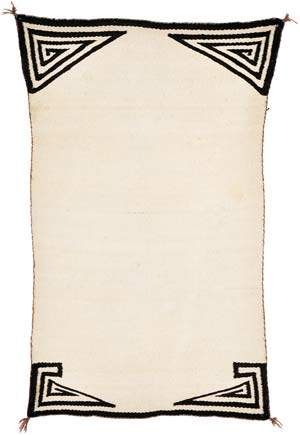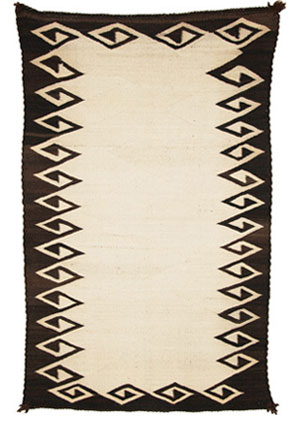In his appraisals, Joshua Baer provides an individual dollar amount for the Fair Market Value of the historic Navajo blanket or rug being appraised.
Under IRS Section 1.170 and 20.2031 (b), the IRS defines Fair Market Value as:
“The price at which the property would change hands between a willing buyer and a willing seller, neither being under any compulsion to buy or sell and both having reasonable knowledge of relevant facts.”
In the art market, Fair Market Value is the price a work of art can be expected to realize either at auction, in an art gallery, or through a private sale within ninety days of being offered for sale. Fair Market Value does not take into account sales commissions which a collector will pay to an art broker, art gallery, or auction company for reselling
a consigned work of art. In a private sale, the seller’s commission can range from 10% to 60% of the final sales price of a work of art. Established auction companies typically collect a 10% commission from the seller plus
a 25% commission, or “buyer’s premium,” from the buyer, plus fees for catalog placement, insurance, and photography. After payment of all commissions and fees, the average consignor receives between 60% and 65% of the final sales price of a work of art sold at public auction.
Replacement Value refers to the retail price a collector will spend in order to replace a damaged, lost, or stolen work of art with a comparable work of art by purchasing the replacement work of art either from an art gallery, auction company, or private collector. In the case of a unique work of art, Replacement Value refers to the retail price a collector will have to pay in order to replace the damaged, lost, or stolen work of art with a comparably unique work of art. Replacement Value does not include the costs of research, time, or travel associated with finding a venue where the replacement work of art may or may not be available for purchase.
The IRS uses Fair Market Value as the value of a work of art being given by its owner as a charitable donation, as long as the donor has owned the work of art for more than one year. Established carriers like Chubb, Lloyd’s, or Traveler’s insure works of art in private collections at their Replacement Values. Claims for damaged, lost, or stolen works of art are settled at Replacement Value, minus
a deductible.
Financial institutions and established auction companies will loan money to art collectors against the Fair Market Values of works of art pledged as collateral. However, the amounts of such loans, terms of such loans, and rates of interest charged for such loans depend more on the borrower’s financial profile than on the Fair Market Values of the works of art pledged as collateral.
The disparity between the Fair Market Values and Replacement Values of works of antique Native American Art contracts and expands according to the strengths and weaknesses of the economy and the art market. During periods of extended strength, Fair Market Values can either equal or temporarily exceed Replacement Values. During periods of extended weakness, Fair Market Values can contract to as little as 25% of Replacement Values.
During the last fifty years, the Fair Market Values of outstanding historic Navajo blankets and rugs either approached or exceeded Replacement Values twice: From November of 1989 through December of 1990, and from August of 2000 through December of 2000. During that same fifty-year period, Fair Market Values contracted to 50% of Replacement Values during the spring of 1984, during the spring of 1993, and during the spring, summer, and fall of 2001.
Fair Market Values for outstanding historic Navajo blankets and rugs currently stand at between 80% and 100% of Replacement Values. In most cases, an historic Navajo blanket or rug of extraordinary rarity will support a Replacement Value in excess of its Fair Market Value. However, the Replacement Value of a Navajo blanket or rug that is commonly available will not exceed its Fair Market Value.
Collectors of antique Native American art can enhance
the values of the works of art in their collections by having those works of art published in books, by having those works of art exhibited in museums, by displaying those works of art to their best advantage in the collectors’ residences, by improving and protecting the condition of those works of art, and by holding those works of art for
a period of three to five years. During the last fifty years, collectors of antique Native American art who consulted and worked with a knowledgeable art consultant or art dealer saw dramatic appreciation in the Fair Market Values and Replacement Values of the works of art in their collections.
Collectors of antique Native American art will reduce the values of the works of art in their collections by displaying those works of art improperly, by offering those works of art for sale on a recreational basis, by consigning those works of art to auction at high reserves, by physically damaging those works of art, by improperly restoring those works of art, and by attempting to re-sell those works of art within less than three years of their dates of acquisition. Invariably, the collector who regards her or his art collection as inventory will lower its aggregate value, regardless of the quality of the individual works of art in
the collection.


